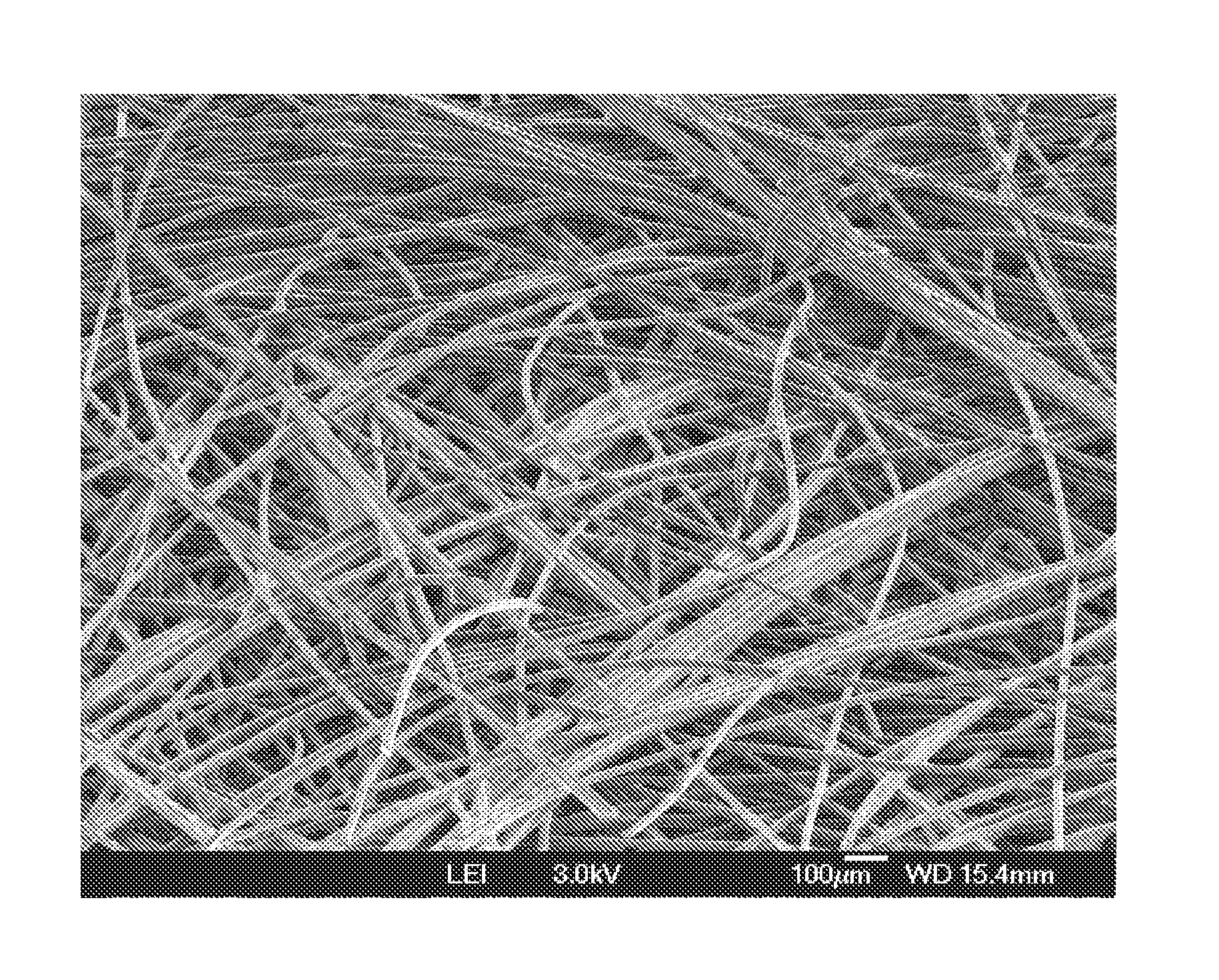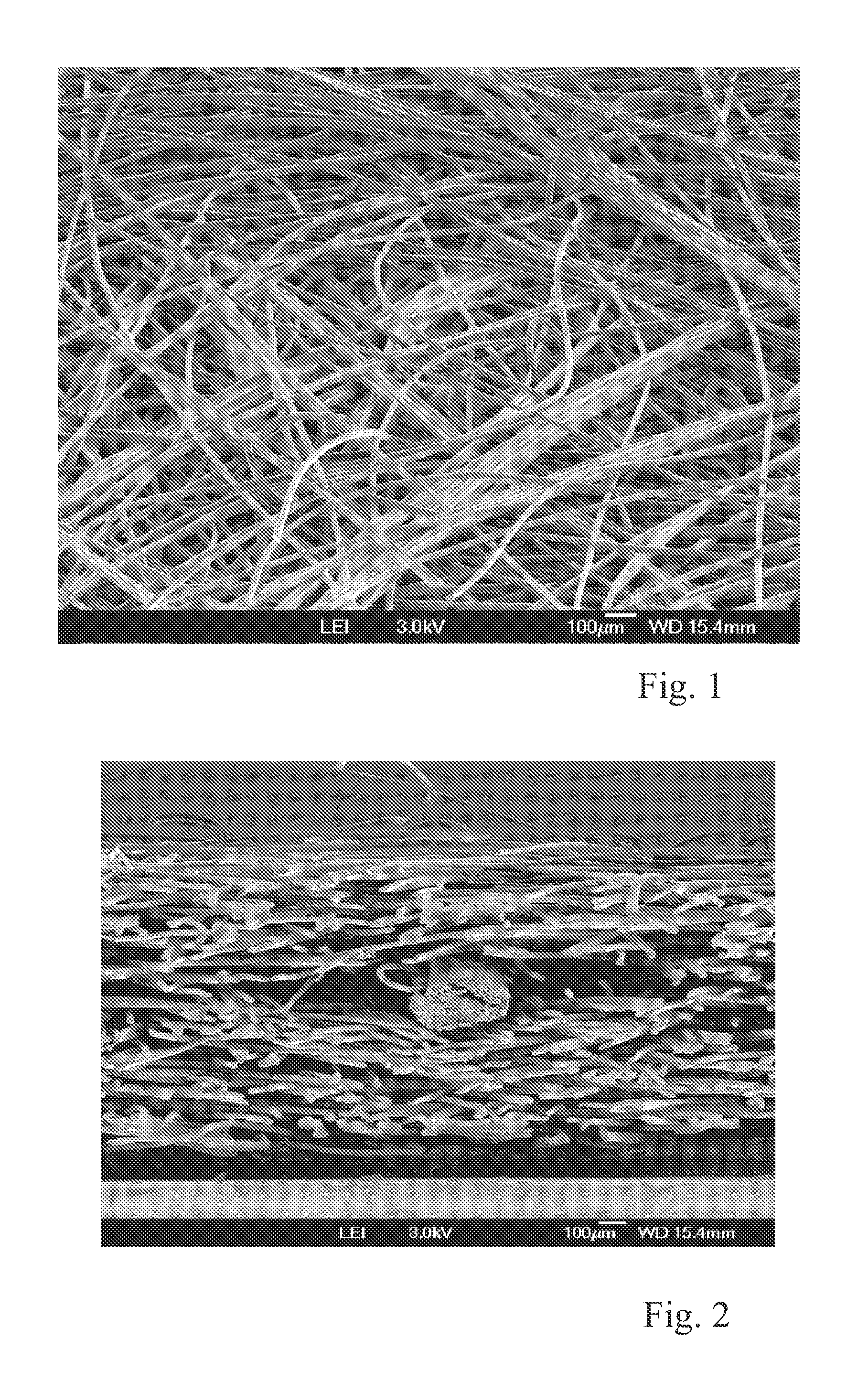Non-woven product that contains organic and/or mineral particles and its process for production
a technology of organic and/or mineral particles and non-woven products, which is applied in the direction of weaving, woven fabrics, non-woven fabrics, etc., can solve the problems of insensitivity to temperature, negatively affecting the stability and/or the modulus of the non-woven product concerned, and simultaneous mechanical and thermal constraints with intensities, etc., to increase the size or weight of the existing binding points, enhance the moduli, and increase the thickness of the product
- Summary
- Abstract
- Description
- Claims
- Application Information
AI Technical Summary
Benefits of technology
Problems solved by technology
Method used
Image
Examples
example 1
Without Particulate Feedstocks
A surface of continuous polyester filaments of 6.0 dtex was prepared at two levels of surface weight 125 and 155 g / m2 following a so-called “spunbond” process. It was the object of a reinforcement by glass threads of 68 Tex introduced at the center of the layer according to the processes described by the document FR 88 16711.
These surfaces were then linked hydraulically at a speed of 20 m / minute, at a rate of once per face, and at four different pressure levels from 130 to 210 bar using nozzles of 130 μm in diameter, whereby the openings are separated by 0.8 mm. These tests are numbered from E1 to E8 in Table 2 below.
These surfaces were then taken up and impregnated in a full bath using a binder that consists of 88% of an acrylic resin and 12% of a melamine in dilution at 70% at a speed of 12 m / min. The binder was dried and then cross-linked at a temperature of 215° C. on a first drum and at 135° C. on a second drum in series.
The carrying level was adju...
example 2
With Particulate Feedstocks
A surface of continuous polyester filaments of 7.0 dtex was prepared according to a “spunbond” process without reinforcement by substrates of very high moduli.
The polymer that is used is a 100% recycled PET of the “bottle flakes” type (flakes of recycled plastic bottles) of Q5 quality.
These surfaces were connected mechanically by needling at a rate of:50 perforations / cm2 12 mm of penetrationUsing 15×18×38 needles of the “regular barb” type before being heat-set at 210° C. starting from a heated calender, and then impregnated using a variable mixture of calcium carbonate and the same acrylic binder as Example 1, this at a speed of 40 m / min.
The binder was dried and then cross-linked at a temperature of 217° C. on a drum of 3.6 m in diameter through which air passes.
The carrying level was adjusted theoretically to a variable level of 21% to 27% dry relative to the weight of the non-woven fabric.
These tests are numbered 1 to 6 in Tables 3 and 4 below.
The calci...
example 3
A surface of continuous polyester filaments of 7.0 dtex was prepared under the same conditions as Example 2, still starting from 100% recycled PET polymer “bottle flakes” (recycled bottle flakes) of quality Q5.
The needling bond as well as the heat-setting and the conditions of impregnation and drying / cross-linking are similar to the preceding example.
The basic surface weight of the non-woven fabric is 195 g / m2. The carrying level was theoretically adjusted to a variable level of 21% to 27% under dry conditions relative to the weight of the non-woven fabric. These tests are numbered 1 to 4 in Tables 5 and 6 below.
The inert feedstocks that are introduced according to the tests consist of mixtures of particles that are determined as indicated.
Calcium carbonate is an Omyalite 60 liquid mud (slurry) of d50% at 1.5 μm and a Durcal 130 of d50% at 170 μm.
The feedstock of polymer particles is produced from the recovery of fines of sieved “bottle flake” fractions (recycled bottle particles) w...
PUM
| Property | Measurement | Unit |
|---|---|---|
| Grain size | aaaaa | aaaaa |
| Grain size | aaaaa | aaaaa |
| Grain size | aaaaa | aaaaa |
Abstract
Description
Claims
Application Information
 Login to View More
Login to View More - R&D
- Intellectual Property
- Life Sciences
- Materials
- Tech Scout
- Unparalleled Data Quality
- Higher Quality Content
- 60% Fewer Hallucinations
Browse by: Latest US Patents, China's latest patents, Technical Efficacy Thesaurus, Application Domain, Technology Topic, Popular Technical Reports.
© 2025 PatSnap. All rights reserved.Legal|Privacy policy|Modern Slavery Act Transparency Statement|Sitemap|About US| Contact US: help@patsnap.com



